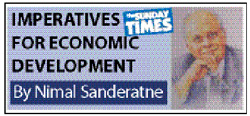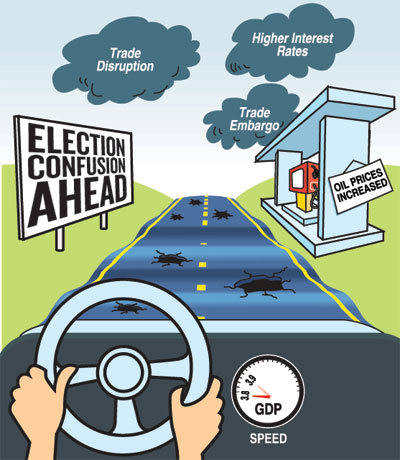Columns
Economic growth revised down amid increased uncertainty
View(s):Adverse international developments and inhospitable conditions in the country have led to a downward revision of the economic growth to less than 4 percent this year. The expectation at the beginning of the year of a significant economic revival this year from the poor performance of GDP growth of 3.1 percent last year is fading.
 The impending US trade embargo on Iran and the policy environment in the country that are not conducive to investment and economic development. The sluggish performance of the economy in the first half of this year diminished the expectation of an economic growth of 4 to 4.5 percent this year. The hope that the economy would perform better in the second half to push the growth beyond 4 percent is unrealistic due to external shocks.
The impending US trade embargo on Iran and the policy environment in the country that are not conducive to investment and economic development. The sluggish performance of the economy in the first half of this year diminished the expectation of an economic growth of 4 to 4.5 percent this year. The hope that the economy would perform better in the second half to push the growth beyond 4 percent is unrealistic due to external shocks.
First half of 2018
The economic growth was lower than expected in the first half of this year too. The economy grew by 3.1 percent in the first quarter and 3.7 percent in the second quarter of this year. This was only a modest revival of the economy from the depressed growth of 3.1 percent last year. This moderate economic growth performance diminished the expectation of economic growth of 4 to 4.5 percent this year. Furthermore, the possibility of the economy performing better in the second half to push growth beyond 4 percent is fading due to external shocks.
 Growth in second quarter
Growth in second quarter
Although the economy grew at a slightly faster pace in the second quarter of this year, it was still below expectations. The Census and Statistics Department estimated the Gross Domestic Product (GDP) growth in the second quarter of this year (April, May, June) as 3.7 percent. The 3.1 percent growth in the first quarter and 3.7 percent in the second quarter of this year are only a modest revival of the economy from the depressed growth of 3.1 percent last year.
Agriculture that contributed only 8.4 percent to GDP grew by 4.5 percent. Food crops and coconut production increased substantially. In contrast tea and rubber output declined by 7.1 and 11.9 percent, respectively. Tea production has continued to decline in July and August thereby depressing growth.
Industries
Industrial production that includes construction contributed about one fourth (25.6 percent) of GDP. Industrial output increased by only 2.3. While manufacturing expanded by 3.2 percent, construction that has been a high growth component, contracted by 6 percent, compared to the second quarter of last year, to increase by only 1.2 percent.
Services
Services that account for nearly 60 percent (57.1) of overall GDP expanded by 4.8 percent in the second quarter of 2018, when compared to the same quarter of 2017. Most subsectors of services expanded. Wholesale and retail trade, Accommodation, food and beverage services, Telecommunication services, Information Technology services, financial services and other service activities increased their output.
Exogenous reasons
Higher US interest rates, appreciation of the US dollar, increasing international fuel prices and reduced demand for tea are affecting the Sri Lankan economy adversely. Protectionist trade policies of the US are expected to depress global economic growth that would in turn affect our exports in due course. These external shocks and inhospitable domestic economic conditions arising from the political confusion and inept governance of the coalition government are exacerbating the unfavourable external factors.
These external shocks and conditions in the country have led international organisations to revise growth expectations for this year downwards to below 4 percent.
IMF, ADB assessments
The IMF projected growth to be below 4 percent this year, and gradually reach 5 percent over the medium-term. It said “Macroeconomic performance has been mixed in the first half of 2018, with growth recovering gradually and inflation stabilising in the mid-single digits.” It observed that the trade deficit widened due to higher fuel imports, despite strong export performance.
The Asian Development Bank (ADB) in its Asian Development Outlook (ADO) report, revised downward Sri Lanka’s GDP growth forecast from 4.2 percent to 3.8 percent in 2018. It also revised the 2019 growth rate from 4.8 to 4.5 percent. It is significant to note that this growth rate in 2018 is below the growth estimate for the sub-region of 7.2 percent. The country is continuing to lag behind the growth of South Asia. The ADB attributes this retardation to “little change expected in investment and Government expenditure” and “A downside risk from the approaching elections”.
Concluding reflections
Sri Lanka continues to lag behind the robust growth of South Asia of 7 percent. While the external environment, especially the current increases in US interest rates, appreciation of the US dollar, increasing fuel prices and the expected embargo on trade with Iran and international trading wars are serious impediments to the country’s economic growth, internal political and economic conditions too are responsible for the less than potential economic performance.


Leave a Reply
Post Comment